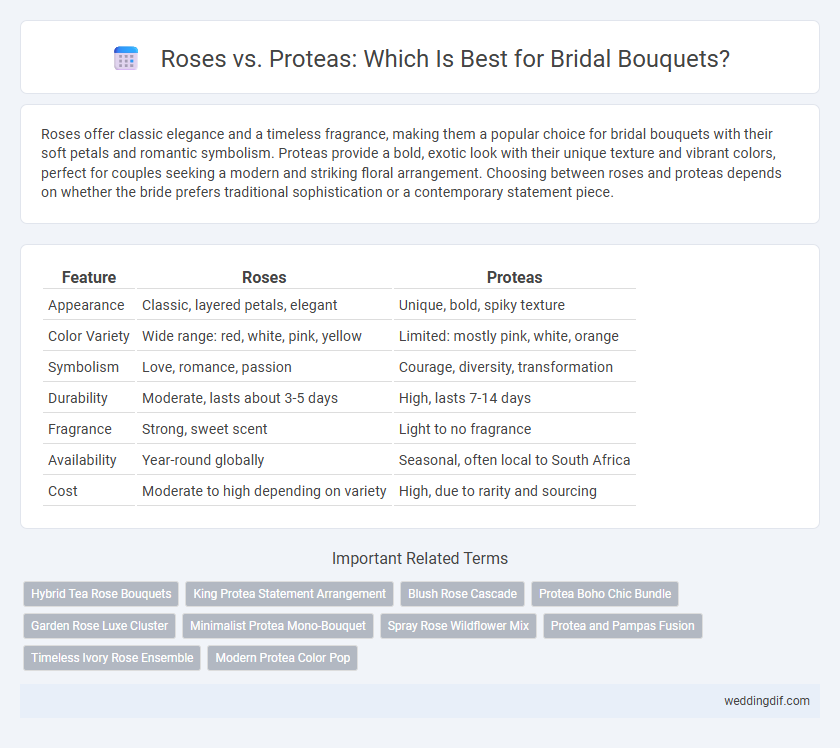Roses offer classic elegance and a timeless fragrance, making them a popular choice for bridal bouquets with their soft petals and romantic symbolism. Proteas provide a bold, exotic look with their unique texture and vibrant colors, perfect for couples seeking a modern and striking floral arrangement. Choosing between roses and proteas depends on whether the bride prefers traditional sophistication or a contemporary statement piece.
Table of Comparison
| Feature | Roses | Proteas |
|---|---|---|
| Appearance | Classic, layered petals, elegant | Unique, bold, spiky texture |
| Color Variety | Wide range: red, white, pink, yellow | Limited: mostly pink, white, orange |
| Symbolism | Love, romance, passion | Courage, diversity, transformation |
| Durability | Moderate, lasts about 3-5 days | High, lasts 7-14 days |
| Fragrance | Strong, sweet scent | Light to no fragrance |
| Availability | Year-round globally | Seasonal, often local to South Africa |
| Cost | Moderate to high depending on variety | High, due to rarity and sourcing |
Timeless Elegance: Roses in Bridal Bouquets
Roses symbolize timeless elegance and have long been a classic choice for bridal bouquets due to their delicate petals and rich fragrance, enhancing the romantic ambiance of weddings. Their wide range of colors allows for versatile styling that complements various wedding themes, from traditional to modern. Unlike proteas, which offer a bold and exotic look, roses exude a soft sophistication that remains iconic in bridal floral arrangements.
Unique Charm: Why Choose Proteas for Your Wedding
Proteas offer a bold and exotic charm that sets bridal bouquets apart with their striking texture and vibrant colors, making them a memorable alternative to traditional roses. Their long-lasting nature and symbolic representation of diversity and courage add meaningful depth to wedding arrangements. Choosing proteas creates a distinctive floral statement that captures attention while celebrating individuality on your special day.
Color Variety: Comparing Roses and Proteas
Roses offer an extensive color palette ranging from classic reds and soft pinks to vibrant yellows and pure whites, making them versatile for any bridal theme. Proteas, while more limited in color options, showcase unique hues such as dusty pinks, coral tones, and creamy whites, adding an exotic touch to bouquets. Choosing between these flowers depends on the desired color impact and overall aesthetic, with roses providing traditional elegance and proteas delivering bold, contemporary flair.
Symbolism: What Roses and Proteas Represent
Roses symbolize love, romance, and passion, making them a timeless choice for bridal bouquets that convey deep emotional connections. Proteas represent courage, transformation, and diversity, offering a unique statement of strength and individuality in wedding floral arrangements. Choosing between roses and proteas depends on whether the bride prefers a classic expression of affection or a bold symbol of personal growth and resilience.
Texture and Structure: Bouquet Styles with Roses vs Proteas
Roses offer a classic, soft texture with layered petals that create a romantic and full bouquet structure, ideal for traditional bridal styles. Proteas provide a bold, architectural texture with their spiky, robust blooms, lending a modern and sculptural look to bouquets. Combining the lush softness of roses with the striking form of proteas results in a dynamic contrast that enhances bouquet depth and visual interest.
Seasonal Availability: Choosing Roses or Proteas
Roses offer year-round availability, making them a reliable choice for bridal bouquets regardless of the wedding season, while proteas tend to be seasonal, thriving mainly in late winter through early summer. When choosing between roses and proteas, consider the wedding date and local climate to ensure the freshest blooms and optimal longevity. Proteas provide a striking, exotic appearance best suited for spring and summer weddings, whereas roses offer timeless elegance and versatility across all seasons.
Budget Considerations: Costs of Roses vs Proteas
Roses generally offer a more affordable option for bridal bouquets with prices ranging from $2 to $5 per stem, making them accessible for various budgets. Proteas, known for their exotic appearance and limited availability, can cost between $10 and $25 per stem, significantly increasing bouquet expenses. Choosing between roses and proteas depends on balancing desired aesthetics with budget constraints, as proteas may elevate costs but provide a unique statement.
Longevity and Freshness: Durability in Bouquets
Roses typically last about one week in bridal bouquets, requiring frequent hydration to maintain freshness, while proteas can endure up to two weeks due to their hardy, waxy petals and thick stems that retain moisture longer. Proteas resist wilting under warm conditions better than roses, making them ideal for outdoor or extended events where bouquet durability is crucial. Choosing proteas over roses ensures a longer-lasting, vibrant bouquet with minimal maintenance throughout the wedding day.
Pairing Options: Flowers that Complement Roses and Proteas
Roses pair beautifully with eucalyptus, baby's breath, and peonies, adding softness and fragrance to bridal bouquets. Proteas complement succulents, greenery like ferns, and textured blooms such as leucadendrons, creating a bold and exotic arrangement. Combining roses and proteas with complementary fillers enhances color contrast and adds depth to wedding floral designs.
Bride Personality: Matching Florals to Your Style
Roses convey timeless elegance and romance, ideal for brides who favor classic, sophisticated styles, symbolizing love and passion. Proteas offer a bold, unconventional choice that suits adventurous brides seeking unique, standout floral designs with a modern, artistic edge. Selecting blooms that reflect the bride's personality ensures the bouquet complements her style, creating a harmonious and memorable wedding aesthetic.
Roses vs Proteas for bridal bouquets Infographic

 weddingdif.com
weddingdif.com